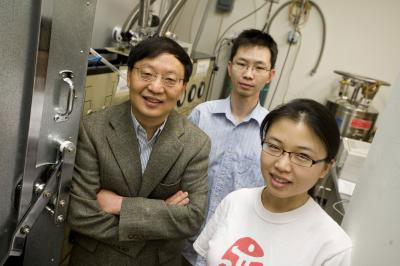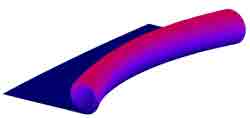 Researchers have developed a novel biosensor chip that not only recognizes proteins that are characteristic for specific diseases, but also can show if these proteins are changed through the influence of disease or drugs.
Researchers have developed a novel biosensor chip that not only recognizes proteins that are characteristic for specific diseases, but also can show if these proteins are changed through the influence of disease or drugs.
Apr 22nd, 2010
Read more
Mimicking the human nervous system for bionic applications could become a reality with the help of a method developed at Oak Ridge National Laboratory (ORNL) to process carbon nanotubes.
Apr 22nd, 2010
Read more
$876.1 million spent on Cconstruction, equipment and operations.
Apr 22nd, 2010
Read more
The London Centre for Nanotechnology (LCN) is pleased to announce the creation of over 20 new Ph. D. positions for the current academic year. The positions cover all aspects of research at the LCN and are available immediately.
Apr 22nd, 2010
Read more
For their achievements in promoting German-Polish cooperation in science, Professor Dr. Alfred Forchel from Wuerzburg and Professor Dr. Jan Misiewicz from Wroclaw, both physicists, will receive the Copernicus Award of the Deutsche Forschungsgemeinschaft (DFG, German Research Foundation) and the Foundation for Polish Science (FNP).
Apr 22nd, 2010
Read more
Science philosopher studies how knowledge is created.
Apr 22nd, 2010
Read more
 A new solar concentrator design from an electrical engineering Ph.D. student at the University of California, San Diego could lead to solar concentrators that are less expensive and require fewer photovoltaic cells than existing solar concentrators.
A new solar concentrator design from an electrical engineering Ph.D. student at the University of California, San Diego could lead to solar concentrators that are less expensive and require fewer photovoltaic cells than existing solar concentrators.
Apr 22nd, 2010
Read more
Hudson Valley Community College marked a milestone in the college's history with the official grand opening ceremony of its new $13.5 million facility, TEC-SMART (Training and Education Center for Semiconductor Manufacturing and Alternative and Renewable Technologies), in Malta, NY.
Apr 22nd, 2010
Read more
Nanyang Business School (NBS) at Nanyang Technological University (NTU), Singapore, has jointly launched a new advanced management programme for leaders in Science and Technology with the Rady School of Management at the University of California, San Diego.
Apr 22nd, 2010
Read more
New research, led by Professor Mark Kendall, from the Australian Institute for Bioengineering and Nanotechnology, demonstrates that a vaccine delivered by a Nanopatch induces a similarly protective immune response as a vaccine delivered by needle and syringe, but uses 100 times less vaccine.
Apr 22nd, 2010
Read more
 Rice physicists: Odd electron mix has fault-tolerant quantum registry.
Rice physicists: Odd electron mix has fault-tolerant quantum registry.
Apr 21st, 2010
Read more
 Can graphene - a newly discovered form of pure carbon that may one day replace the silicon in computers, televisions, mobile phones and other common electronic devices - be made to bend, twist and roll? Physicists at UC San Diego and Boston University think so.
Can graphene - a newly discovered form of pure carbon that may one day replace the silicon in computers, televisions, mobile phones and other common electronic devices - be made to bend, twist and roll? Physicists at UC San Diego and Boston University think so.
Apr 21st, 2010
Read more
It was shown that the presence of hydrogen and/or inert species during Ge deposition significantly improves the quality of the Ge layers grown on Si by solid phase epitaxy.
Apr 21st, 2010
Read more
Researchers at imec have developed an innovative strategy to tune plasmon resonances. They do so by breaking the symmetric geometry of the nanostructures, using a combination of bottom-up and top-down fabrication processes.
Apr 21st, 2010
Read more
Recent modeling results obtained in imec for a GaAs and Si nanowire indicate that the nanowire pinch-off FET can outperform the nanowire MOSFET. These results combined with scalability and ease of processing make the junctionless transistor a true competitor for the nanowire MOSFET.
Apr 21st, 2010
Read more
The Cambridge Lab of Toshiba Research Europe today announced a major breakthrough that will allow ultra-secure encryption of sensitive data sent by banks, hospitals and government organisations.
Apr 21st, 2010
Read more
 Researchers have developed a novel biosensor chip that not only recognizes proteins that are characteristic for specific diseases, but also can show if these proteins are changed through the influence of disease or drugs.
Researchers have developed a novel biosensor chip that not only recognizes proteins that are characteristic for specific diseases, but also can show if these proteins are changed through the influence of disease or drugs.



 Subscribe to our Nanotechnology News feed
Subscribe to our Nanotechnology News feed